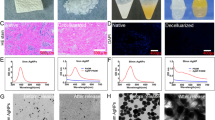Abstract
Wound infection is a common complication often resulting in delayed healing with adverse clinical and financial consequences. Current antimicrobial treatments are far from ideal, side effects can include both bacterial resistance and toxicity. As a result, a great deal of effort over the last 20 years has been spent on investigating new forms of antimicrobial dressings. Here, we report the unexpected antimicrobial activity of a relatively new biocompatible thermo-responsive PHPMA–PMPC–PHPMA triblock copolymer gelator [where PHPMA denotes poly(2-hydroxypropyl methacrylate) and PMPC denotes poly(2-(methacryloyloxy)ethyl phosphorylcholine)]. In a radial diffusion assay, a 20% w/v copolymer gel produced an inhibitory zone up to six times greater than the corresponding control against Staphylococcus aureus. Similarly, in a broth inhibition assay the same copolymer reduced bacterial growth by 45% compared with control experiments conducted in the absence of any copolymer. Moreover, addition of the copolymer to a 3D-infected skin model reduced bacterial recovery by 38% compared to that of controls over 24–48 h. This is particularly relevant since these antimicrobial triblock copolymers were recently shown to be non-toxic when exposed to a tissue-engineered skin model. This antimicrobial activity was also successfully immobilised by grafting PMPC–PHPMA diblock copolymer brushes onto silicon wafers. Our results indicate that both PMPC–PHPMA diblock and PHPMA homopolymer brushes exhibit antimicrobial activity. Our hypothesis for the mode of action is that the moderately hydrophobic PHPMA chains penetrate the bacterial membrane, causing leakage of the cell contents. In summary, these gels and surfaces offer a promising new approach to antimicrobial dressings.









Similar content being viewed by others
References
Farage MA, Miller KW, Elsner P, Maibach HI (2008) Aging Clin Exp Res 20:195
Singer AJ, Clark RAF (1999) New Engl J Med 341:738
Scheinfeld N (2005) Dermatol Online J 11(3):8
Bowler PG, Duerden BI, Amstrong DG (2001) Clin Microbiol Rev 14:244
Hermans HM (2006) Am J Nurs 106:60
Atiyeh BS, Costagliola M, Hayek SN, Dibo SA (2007) Burns 33:139
Faulkner DM, Sutton ST, Hesford JD, Faulkner CB, Major DA, Hellewell TB, Laughon MM, Rodeheaver GT, Edlich RF (1997) Am J Emerg Med 15:20
Ilker FM, Nusslein K, Tew GN, Coughlin EB (2004) J Am Chem Soc 126:15870
Eren T, Som A, Rennie JR, Nelson CF, Urgina Y, Nusslein K, Coughlin EB, Tew GN (2008) Macromol Chem Phys 209:516
Kuroda K, Caputo GA, DeGrado WF (2009) Chemistry 15:1123
Madsen J, Armes SP, Lewis AL (2006) Macromolecules 39:7455
Madsen J, Armes SP, Bertal K, Lomas H, MacNeil S, Lewis AL (2008) Biomacromolecules 9:2265
Shepherd J, Douglas I, Rimmer S, Swanson L, MacNeil S (2009) Tissue Eng Part C 15(3):475
Tsarevsky NV, Matyjaszewski K (2005) Macromolecules 38:3087
Tsarevsky NV, Matyjaszewski K (2002) Macromolecules 35:9009
Ostmark E, Harrison S, Wooley KL, Malmstrom EE (2007) Biomacromolecules 8:1138
Ghosh MM, Boyce SG, Layton C, Freedlander E, MacNeil S (1997) Ann Plast Surg 39:390
Schaberg DR, Culver DH, Gaynes RP (1991) Am J Med 91:72S
Fleischmann W, Meyer H, Baer AV (1996) J Hosp Infect 34:107
Eliott D, Kufera JA, Myers RA (2000) Am J Surg 179:361
Church D, Elsayeed S, Reid O, Winston B, Lindsay R (2006) Clin Microbiol Rev 19:403
Jones MV, Herd TM, Christie HJ (1989) Microbios 58:49
Brogden KA (2005) Nat Rev Microbiol 3:238
Edlich RF, Schmolka IR, Prusak MP, Edgerton MT (1973) J Surg Res 14:277
Rodeheaver GT, Kurtz L, Kircher BJ, Edlich RF (1980) Ann Emerg Med 11:572
Rodeheaver GT, Smith SL, Thacker JG, Edgerton MT, Edlich RF (1975) Am J Surg 129:241
Holder IA, Durkee P, Supp AP, Boyce ST (2003) Burns 29:445
Martineau L, Dosch HM (2006) Burns 32:748
Jones SA, Bowler PG, Walker M, Parsons D (2004) Wound Repair Regen 12:288
Steer JA, Papini RPG, Wilson APR, McGrouther DA, Parkhouse N (1996) Burns 22:177
Kuroda K, DeGrado WF (2005) J Am Chem Soc 127:4128
Madsen J, Armes SP, Bertal K, MacNeil S, Lewis A (2009) Biomacromolecules (in press)
Cerca N, Pier GB, Vilanova M, Oliveira R, Azeredo J (2005) Res Microbiol 156:506
Tebbs SE, Elliott TSJ (1994) Eur J Clin Microbiol Infect Dis 13:111
Acknowledgements
We thank the Algerian government for funding a PhD studentship for K. Bertal. S. P. Armes is a recipient of a 5-year Royal Society/Wolfson Research Merit Award. We thank Biocompatibles for CASE support of two PhD studentships for K. Bertal and J. Madsen, for donating the MPC monomer and also for permission to publish this study.
Author information
Authors and Affiliations
Corresponding author
Rights and permissions
About this article
Cite this article
Bertal, K., Shepherd, J., Douglas, C.W.I. et al. Antimicrobial activity of novel biocompatible wound dressings based on triblock copolymer hydrogels. J Mater Sci 44, 6233–6246 (2009). https://doi.org/10.1007/s10853-009-3843-7
Received:
Accepted:
Published:
Issue Date:
DOI: https://doi.org/10.1007/s10853-009-3843-7




